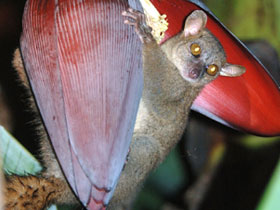The northern giant mouse lemur (Mirza zaza), or northern dwarf lemur
 Mirza zaza is included in the IUCN Red List as an endangered species
Mirza zaza is included in the IUCN Red List as an endangered species
The northern giant mouse lemur (Mirza zaza), or northern dwarf lemur, is a species of lemur discovered in 2005. They are part of the primate order, and classified in the family Cheirogaleidae.
Description
Prior to the discovery of this species, the genus of giant mouse lemurs was considered monotypic.
Mirza zaza is a small nocturnal lemur (weighing less than 300 grams) and endemic to Madagascar. Body length 23-25 cm (not including the tail). The tail is long (26 to 29 cm). They have a short, greyish-brown coat. The long, fluffy tail is darker towards the end. The head is rounded, the eyes are relatively large and the ears are round and much smaller than those of closely related lemur species. They have common sleeping nests.
Etymology
The word zaza means child in Malagasy. The name was chosen because the northern giant mouse lemur is the smaller of the two giant mouse lemur species, and because of a wish to emphasize the responsibility of the current generation of Malagasy children for the conservation of Malagasy animals for future generations.
Distribution
The M. zaza are found in a strictly limited region in the north-western part of Madagascar, the Ampasindava peninsula. The habitat is split by two rivers, the Mahavavy River to the north and the Maevarano River to the south. In some areas it is further separated by the Sambirano River. This area in Madagascar has a dry and cool season from May to October, and a wet and hot season from November to April. The species can be found in a transition zone which goes to the Sambirano evergreen rainforest that extends to the north. Home ranges cover 0.52 - 2.34 ha. There is no substantial overlap in home ranges among individuals. An estimated 385 - 1,086 individuals per km2 are present throughout the region.
Behavior
The species has a polygynandrous mating system, likely based on the large size of the testes, which engenders strong sperm competition. Breeding is aseasonal.
The northern mouse lemur is nocturnal, feeding predominantly during the second half of the night. On average, individuals stay approximately 7 meters up in the canopy. During the day they sleep in group-exclusive tree holes. Nesting groups are 2 - 8 individuals in size, made up of both sexes and any age class, and include unrelated males.
Conservation
The species is classified as vulnerable by the IUCN primarily due to loss of habitat. The deciduous forests that they live in are being logged, fragmented, and degraded. The species is listed in CITES Appendix I.
Reproduction
The mirza zaza has the largest testicles among primates (relative to body size). As males of this species weigh about 280 grams, the testicles account for 5.5% of the total body volume. In humans, the male testes occupy an average of 0.05% of the body volume (i.e. with comparable proportions, human testes could weigh up to 4 kg).
Such a large relative size presumably indicates a year-round mating cycle (rare in all lemuriformes). In addition, the species exhibits both polygamy and polyandry. Up to three males can be found in a nest together with one female. The males use these giant testicles to increase their chances of impregnating their chosen mate.
















































